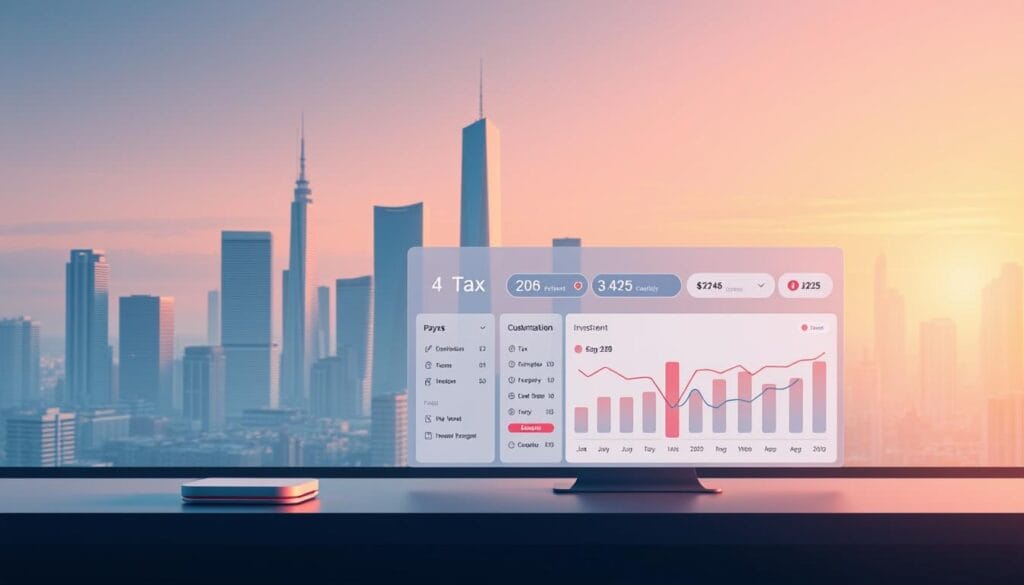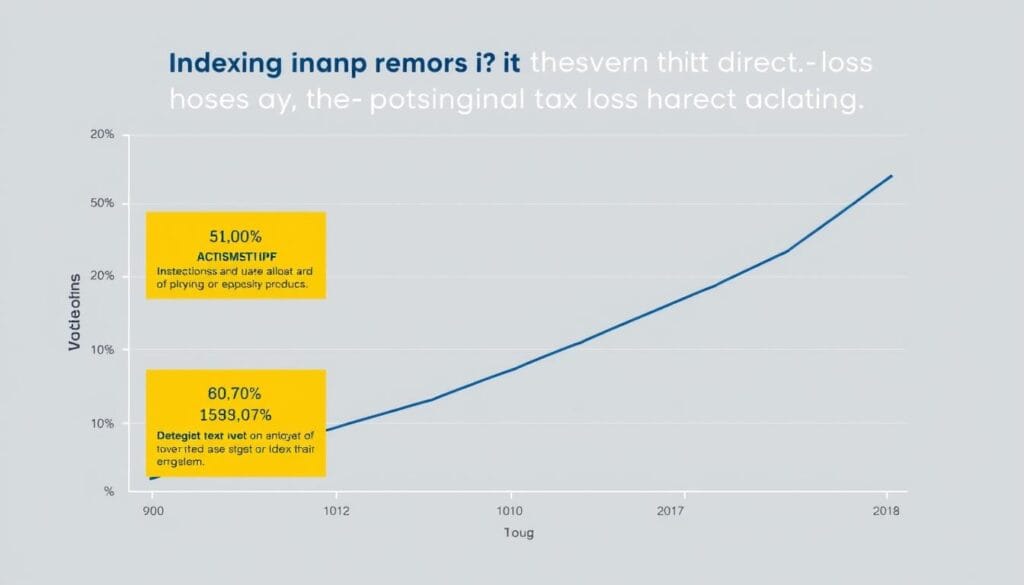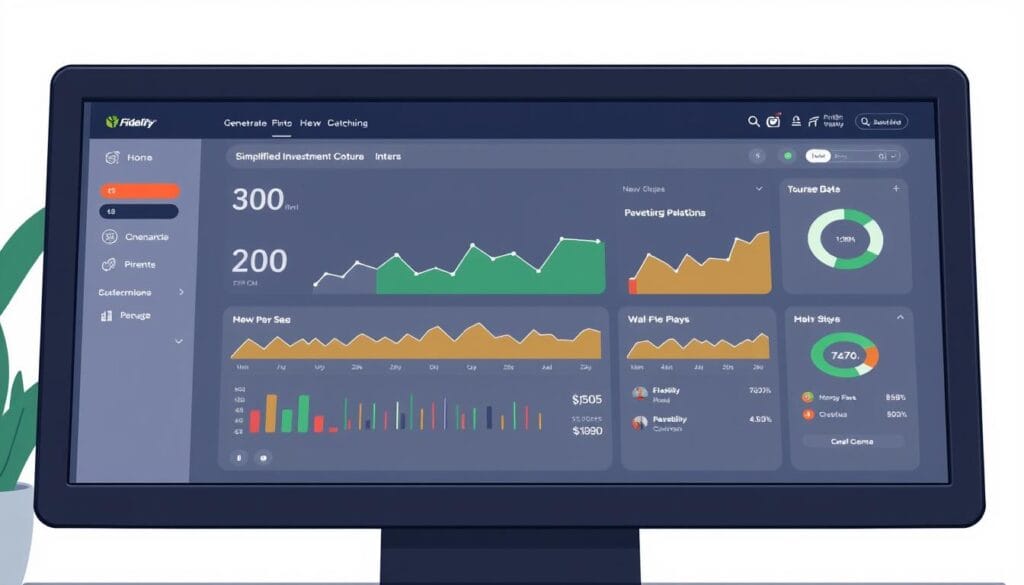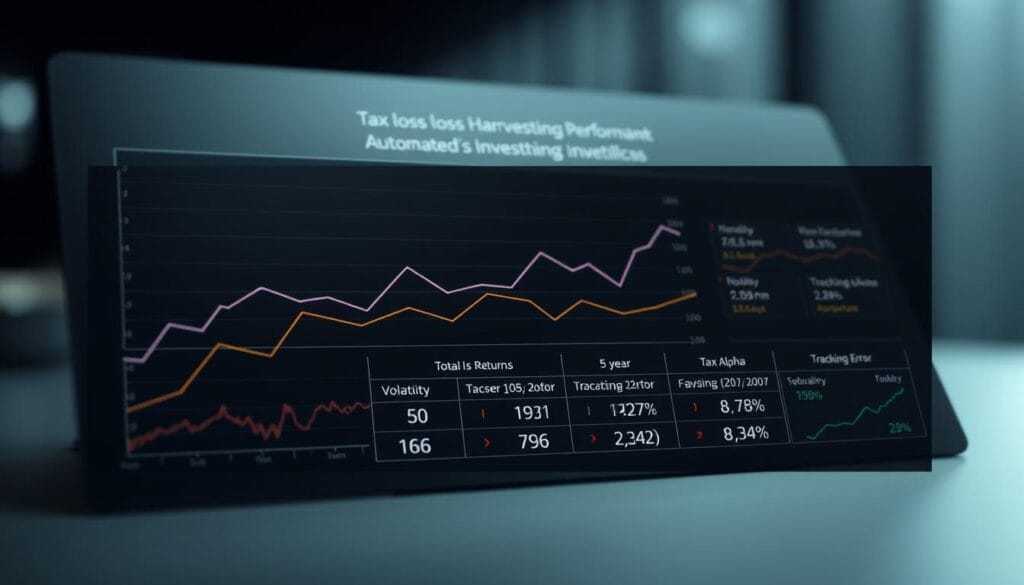Did you know that automated investment platforms can significantly reduce tax liabilities for investors through sophisticated strategies like tax-loss harvesting? As of 2025, leading robo-advisors have made this feature a staple, allowing investors to optimize their tax efficiency while maintaining portfolio performance.
By leveraging advanced algorithms to monitor and adjust investment portfolios daily, these platforms can identify tax-loss harvesting opportunities that human advisors might miss, potentially leading to higher after-tax returns, especially for high-net-worth investors with taxable accounts.
Key Takeaways
- Leading robo-advisors in 2025 offer advanced tax-loss harvesting features.
- Automated platforms can significantly reduce tax liabilities.
- Daily monitoring of portfolios identifies potential tax savings.
- High-net-worth investors benefit most from these strategies.
- Comparing management fees and tax optimization features is crucial.
Understanding Tax Efficiency in Investment Portfolios

The importance of tax efficiency in investment portfolios cannot be overstated, as it directly affects investors’ net returns. Tax efficiency is crucial for maximizing after-tax returns, making it a vital consideration for investors.
What Is Tax-Loss Harvesting and Why It Matters
Tax-loss harvesting is a sophisticated investment strategy that involves selling securities that have declined in value to realize losses. These losses can then be used to offset gains from other investments, reducing tax liability. This strategy is particularly beneficial for investors with significant taxable investments.
The process works by realizing capital losses that can be applied against capital gains, potentially reducing an investor’s tax burden. By doing so, investors can maintain their overall portfolio allocation through the purchase of replacement securities.
The Impact of Taxes on Investment Returns
Taxes can significantly impact investment returns, eroding the value of investment portfolios over time. Research indicates that tax-efficient investing can preserve an additional 1-2% annually compared to tax-agnostic approaches.
Understanding the distinction between tax-loss harvesting in taxable accounts versus retirement accounts is crucial. The strategy primarily benefits taxable investment accounts where capital gains taxes apply, making it an essential consideration for investors seeking to optimize their investment portfolios.
How Robo-Advisors Revolutionize Tax-Efficient Investing

The integration of technology in investment management has led to the development of tax-efficient robo-advisors. These platforms utilize sophisticated algorithms to optimize investment portfolios, minimizing tax liabilities through strategies such as tax-loss harvesting. By leveraging advanced technology, robo-advisors can monitor and adjust portfolios continuously, a significant improvement over traditional manual methods.
Automated vs. Manual Tax-Loss Harvesting
Robo-advisors employ automated tax-loss harvesting strategies, scanning portfolios daily to identify opportunities to offset gains with losses. This approach is more efficient and effective than manual tax-loss harvesting, which is typically performed less frequently by human financial advisors. The computational power of robo-advisors enables them to manage complex tax strategies across multiple accounts simultaneously, maintaining consistency even in volatile markets.
Quantitative research indicates that automated tax-loss harvesting can potentially generate 0.5% to 1.5% in additional after-tax returns annually compared to manual approaches, particularly during periods of market volatility. For a detailed comparison of robo-advisor performance, you can refer to robo-advisor performance reviews.
The Technology Behind Algorithmic Tax Optimization
The technical architecture of robo-advisors includes advanced portfolio analysis tools that evaluate tax implications across various account types and security classes. Machine learning algorithms continuously analyze market conditions, security correlations, and tax implications to identify optimal harvesting opportunities while avoiding wash sale rule violations. This sophisticated technology represents a significant advancement in portfolio management, enabling more efficient and effective tax optimization.
By utilizing these advanced technologies, robo-advisors can provide tax-efficient investing solutions that are tailored to individual investor needs, enhancing overall portfolio performance. As the investment landscape continues to evolve, the role of robo-advisors in tax-efficient investing is likely to become increasingly important.
Key Features to Look for in Tax-Efficient Robo-Advisors

The effectiveness of a robo-advisor in minimizing tax liabilities depends on its specific features and capabilities. When evaluating tax-efficient robo-advisors, investors should consider several critical components that work together to optimize their investment portfolios.
Daily Tax-Loss Harvesting Capabilities
Daily tax-loss harvesting represents the gold standard for tax-efficient robo-advisors. This feature involves continuous monitoring of portfolios to identify and capitalize on tax-loss harvesting opportunities as they arise, rather than relying on periodic reviews. Automated daily tax-loss harvesting can significantly enhance the tax efficiency of an investment portfolio.
Portfolio Rebalancing Frequency
The frequency at which a robo-advisor rebalances a portfolio can have a substantial impact on its tax efficiency. Threshold-based rebalancing, which triggers rebalancing when a portfolio deviates from its target allocation by a specific percentage, typically outperforms calendar-based approaches. This method helps maintain the desired risk profile while minimizing unnecessary transactions that could trigger tax liabilities.
Tax-Coordinated Portfolio Options
Tax-coordinated portfolio technology is another crucial feature that optimizes asset location across different account types. By strategically placing tax-inefficient assets in tax-advantaged accounts and tax-efficient investments in taxable accounts, investors can potentially add 0.10% to 0.82% to their after-tax returns annually. This approach requires sophisticated algorithms and a deep understanding of tax implications.
When selecting a robo-advisor, investors should also consider additional features such as direct indexing capabilities, wash sale prevention mechanisms, and the computational sophistication of harvesting thresholds. By carefully evaluating these features, investors can choose a robo-advisor that aligns with their tax strategies and investment goals, ultimately enhancing their overall investment performance.
Top Robo-Advisors for Tax-Loss Harvesting 2025

Our analysis identifies the top robo-advisors for tax-loss harvesting in 2025 based on their algorithmic sophistication and harvesting frequency capabilities. When evaluating robo-advisors for tax-loss harvesting, key factors include the frequency of harvesting opportunities, minimum investment requirements, management fees, and the sophistication of the tax optimization algorithms.
Selection Criteria and Methodology
The technical evaluation methodology for identifying the top tax-loss harvesting platforms in 2025 incorporates quantitative analysis of historical tax alpha generation across various market conditions. The selection criteria include algorithmic sophistication, harvesting frequency capabilities, minimum harvesting thresholds, wash sale rule compliance mechanisms, and integration with comprehensive tax planning features.
The technical assessment framework evaluates each platform’s computational efficiency in identifying harvesting opportunities across various asset classes and market conditions. Comparative analysis includes examination of fee structures relative to potential tax savings, with particular attention to breakeven analysis for various portfolio sizes and tax brackets.
The methodology incorporates both quantitative performance metrics and qualitative assessment of user interface design, reporting capabilities, and integration with tax documentation systems. By considering these factors, investors can make informed decisions about their investment choices and optimize their tax strategies.
Betterment: Premium Tax Optimization

Betterment’s premium tax optimization services offer a sophisticated approach to tax-efficient investing. With its advanced features and technology, Betterment is well-positioned to help investors minimize tax liabilities and maximize after-tax returns.
Tax-Loss Harvesting Features
Betterment’s tax optimization algorithm performs daily scanning for tax-loss harvesting opportunities across all asset classes. This technical capability allows for harvesting losses at the individual security level when beneficial. The platform’s Premium tier, with a $100,000 account minimum, provides sophisticated tax coordination across multiple account types, potentially generating an additional 0.48% in annual after-tax returns according to Betterment’s backtested data.
The algorithmic approach includes sophisticated wash sale prevention across linked accounts and automatic reinvestment in correlated but not substantially identical securities. This maintains market exposure while capturing tax benefits. Technical integration with tax documentation systems allows for seamless export of tax-loss harvesting transactions to major tax preparation software, reducing administrative complexity.
Management Fees and Account Minimums
Betterment’s management fee structure operates on a sliding scale from 0.25% to 0.65% depending on the service tier. Quantitative analysis shows that the breakeven point for tax benefits typically occurs at portfolios exceeding $50,000. The account minimum is $0 for the Digital tier, while the Premium tier requires a $100,000 minimum. For balances under $20,000, there’s a $4 monthly fee, with discounts available for balances above $1 million.
Pros and Cons for Tax-Conscious Investors
For tax-conscious investors, Betterment offers several advantages, including its sophisticated tax-loss harvesting capabilities and premium tax coordination features. However, the management fees and account minimums for the Premium tier may be a consideration for some investors. To explore more robo-advisors that offer tax-efficient investing options, visit our comprehensive guide on the top 10 best robo-advisors for 2025.
Overall, Betterment’s premium tax optimization services provide a robust solution for investors seeking to minimize tax liabilities and maximize their after-tax returns.
Wealthfront: Direct Indexing Advantage

With its cutting-edge technology, Wealthfront offers a unique direct indexing advantage. Wealthfront’s platform is designed to optimize investment returns through sophisticated tax strategies, including tax-loss harvesting and direct indexing.
Tax-Loss Harvesting and Direct Indexing Explained
Wealthfront’s direct indexing technology allows for security-level tax optimization, rather than fund-level harvesting, for accounts exceeding certain thresholds. This approach can potentially generate up to 2.03% in additional after-tax returns annually for eligible accounts, according to Wealthfront’s published research. The platform’s algorithmic approach to direct indexing incorporates sophisticated risk management to maintain factor exposures and risk characteristics while harvesting individual security losses.
The management fee for Wealthfront’s services is 0.25 percent, with an account minimum of $500. While the full benefits of direct indexing require significantly higher investment levels to achieve optimal tax efficiency, Wealthfront’s low account minimum provides accessibility to a wide range of investors.
Management Fees and Account Minimums
Technical analysis of Wealthfront’s management fee structure relative to potential tax alpha shows particularly favorable economics for portfolios between $100,000 and $1 million. The flat 0.25% fee is competitive, especially considering the potential tax benefits that can be achieved through Wealthfront’s tax-loss harvesting and direct indexing capabilities.
Pros and Cons for Tax-Conscious Investors
For tax-conscious investors, Wealthfront offers several advantages, including sophisticated tax strategies and a low account minimum. However, it’s essential to consider the investment requirements for optimal tax efficiency and the potential impact of management fees on overall returns. To learn more about choosing the right robo-advisor for your needs, visit our guide on how to choose the right robo-advisor.
Charles Schwab Intelligent Portfolios: Free Tax-Loss Harvesting

By leveraging sophisticated algorithms, Charles Schwab Intelligent Portfolios enables investors to maximize their tax savings through efficient tax-loss harvesting. This feature is particularly beneficial for investors with significant portfolios, as it helps minimize tax liabilities.
Charles Schwab Intelligent Portfolios offers several key features that make it an attractive option for tax-conscious investors. Some of the notable features include:
Tax-Loss Harvesting Features
The platform’s tax-loss harvesting algorithm is designed to automatically identify and capitalize on opportunities to offset gains from other investments. This is achieved through the sale of securities that have declined in value, thereby reducing the overall tax burden on the investor.
Key aspects of the tax-loss harvesting feature include:
- Automatic activation for accounts exceeding $50,000
- Daily monitoring across multiple asset classes
- Sophisticated wash sale prevention technology to maintain IRS compliance
Management Fees and Account Minimums
One of the significant advantages of Charles Schwab Intelligent Portfolios is its fee structure. The basic tier comes with no management fee, making it an attractive option for cost-sensitive investors. However, there are account minimums to consider: $5,000 for the basic tier and $25,000 for the Premium tier, which comes with a $30 monthly fee and a one-time $300 setup fee.
Pros and Cons for Tax-Conscious Investors
While Charles Schwab Intelligent Portfolios offers compelling tax-loss harvesting features, investors should weigh the pros and cons. On the positive side, the absence of management fees for the basic tier and the sophisticated tax-loss harvesting algorithm are significant advantages. However, the cash allocation requirement, which can range from 6-30% of the portfolio, may impact the overall tax efficiency.
Investors should carefully consider these factors in the context of their individual financial goals and tax situations to determine if Charles Schwab Intelligent Portfolios is the right choice for their investment needs.
Fidelity Go: Simplified Tax Approach

Fidelity Go’s tax efficiency strategy is designed to be both effective and easy to understand. This approach is particularly beneficial for investors who are new to tax-efficient investing or those who prefer a more straightforward method.
Tax-Efficiency Features
Fidelity Go employs a technically distinct approach to tax efficiency, focusing on tax-aware fund selection rather than active tax-loss harvesting. It utilizes municipal bond funds and tax-efficient ETFs in taxable accounts, providing a passive tax management strategy.
The platform’s tax-aware fund selection is a key feature that sets it apart from more aggressive tax-loss harvesting platforms. This method is particularly efficient for investors in higher tax brackets seeking simplicity.
Management Fees and Account Minimums
Fidelity Go’s management fee structure is straightforward: $0 for accounts with less than $25,000, and 0.35% for accounts above $25,000. The account minimum is $0, although $10 is required to start investing.
This fee structure creates a technical inflection point at $25,000, where investors should evaluate the relative value of Fidelity’s simplified approach versus more aggressive tax-loss harvesting strategies.
Pros and Cons for Tax-Conscious Investors
For tax-conscious investors, Fidelity Go offers several advantages, including its simplified tax approach and low management fees. However, investors with larger portfolios may find that more aggressive tax-loss harvesting strategies offer greater benefits.
The minimal account minimum and integration with comprehensive tax planning tools make Fidelity Go an accessible and holistic tax management solution.
Interactive Advisors: Customizable Tax Strategies

With Interactive Advisors, investors can benefit from sophisticated tax optimization techniques tailored to their individual needs. The platform offers a range of portfolios that can be tailored to specific investment goals and tax situations.
Tax-Efficiency Features
Interactive Advisors provides technically sophisticated customizable tax strategies that allow investors to set specific tax efficiency parameters based on their individual tax situations and investment goals. The platform’s technical architecture enables tax-aware trading across multiple portfolio types, with particular efficiency in its Asset Allocation portfolios.
Management Fees and Account Minimums
The management fee for Asset Allocation portfolios is 0.20 percent, while thematic portfolios range from 0.10 to 0.75 percent. The account minimum is $100, although this can vary depending on the thematic fund chosen. Investors should consider these factors when evaluating the overall cost-effectiveness of the platform.
Pros and Cons for Tax-Conscious Investors
Interactive Advisors offers several advantages, including tax-aware transitions for existing portfolios, which minimize tax impact when transferring assets. However, the variable account minimum structure and differing management fees across portfolio types may require careful consideration. For more information on planning your retirement with robo-advisors, visit our guide on the best robo-advisors of 2025.
Comparing Tax-Loss Harvesting Effectiveness Across Platforms

The impact of tax-loss harvesting on investment returns can vary greatly depending on the platform used. As investors seek to maximize their after-tax returns, understanding the nuances of tax-loss harvesting across different robo-advisor platforms becomes increasingly important.
When evaluating the effectiveness of tax-loss harvesting, it’s crucial to consider performance metrics in different market conditions. Technical comparative analysis of tax-loss harvesting algorithms reveals significant performance variations during different market conditions. Volatility-responsive systems typically outperform calendar-based approaches, demonstrating the importance of adaptive strategies.
Performance Metrics in Different Market Conditions
Quantitative backtesting across multiple market cycles, such as the 2008-2009 financial crisis, the 2020 pandemic, and the 2022 correction, shows that platforms with daily harvesting capabilities generated 0.3-0.7% higher tax alpha during high-volatility periods compared to quarterly systems. This difference underscores the value of frequent monitoring and adjustment in tax-loss harvesting strategies.
Tax Savings Potential: Real-World Examples
Statistical analysis of tax savings potential reveals non-linear relationships between portfolio size and tax benefits. Optimal results typically occur in portfolios between $250,000 and $2 million across most platforms. For instance, investors in higher tax brackets with larger taxable accounts tend to benefit most from sophisticated tax-loss harvesting strategies.
Real-world performance data indicates that tax-loss harvesting effectiveness correlates strongly with portfolio diversification and security count. Direct indexing approaches show particular strength in portfolios with sufficient scale for security-level optimization. This highlights the importance of considering both the platform’s capabilities and the investor’s specific circumstances when evaluating tax-loss harvesting effectiveness.
By examining these factors and understanding how different platforms perform under various market conditions, investors can make more informed decisions about their investment choices and potentially enhance their after-tax returns.
How to Choose the Right Tax-Efficient Robo-Advisor for Your Needs
The process of selecting a robo-advisor that meets your tax efficiency needs involves evaluating several key characteristics. Investors must consider their individual financial situations, investment goals, and the specific features offered by different robo-advisors.
Assessing Your Tax Situation and Investment Goals
A technical assessment of your tax situation is crucial. This involves a quantitative analysis of marginal tax rates, expected capital gains, existing loss carryforwards, and state tax considerations to determine optimal tax-loss harvesting thresholds. Sophisticated investors should evaluate the technical compatibility between their investment goals and a platform’s tax optimization algorithms, particularly regarding time horizon, liquidity needs, and risk tolerance parameters.
For instance, consider the case of an investor in a higher tax bracket with significant capital gains. In this scenario, a robo-advisor with advanced tax-loss harvesting capabilities can help minimize tax liabilities. As robo-advisory investment platforms evolve, they offer more sophisticated tax optimization strategies that can significantly impact an investor’s returns.
Account Types and Tax Implications
Account type selection creates significant technical implications for tax efficiency. Taxable accounts benefit from harvesting, while retirement accounts require different optimization strategies focused on tax-deferred or tax-free growth. Investors should consider the tax implications of their account types when choosing a robo-advisor.
“Tax-loss harvesting is a crucial strategy for minimizing tax liabilities in investment portfolios.”
Balancing Fees Against Potential Tax Savings
A quantitative breakeven analysis comparing management fees against potential tax savings reveals that higher-fee platforms with sophisticated harvesting algorithms often justify their cost for investors in higher tax brackets with larger portfolios. Technical evaluation should include analysis of a platform’s tax documentation capabilities, integration with tax preparation software, and ability to generate specialized reports for complex tax situations.
When evaluating robo-advisors, consider factors such as minimum requirements to open an account, the selection of investments or portfolios offered, any additional fees, and whether or not it offers access to human financial advisors. By carefully assessing these factors and aligning them with your investment goals and tax situation, you can choose a robo-advisor that maximizes your investing efficiency and minimizes unnecessary fees over time.
Common Misconceptions About Tax-Loss Harvesting
Investors often misunderstand the nuances of tax-loss harvesting, leading to suboptimal investment decisions. Tax-loss harvesting is a sophisticated investment strategy that involves selling securities that have declined in value to realize losses, which can then be used to offset gains from other investments.
While tax-loss harvesting is a legitimate tax deferral strategy recognized by the IRS, it is often misconstrued as tax avoidance. However, there is a crucial distinction between the two.
Distinguishing Tax-Loss Harvesting from Tax Avoidance
Tax-loss harvesting is not tax avoidance; rather, it is a legitimate tax strategy that allows investors to defer taxes on their investments. The key difference lies in the fact that tax-loss harvesting involves realizing losses to offset gains, whereas tax avoidance involves evading taxes altogether.
A quantitative analysis of tax-loss harvesting reveals that it primarily accelerates the recognition of losses that would otherwise be realized later, creating present value benefits through time value of money principles. This strategy requires a sophisticated understanding of tax laws and regulations, as well as a thorough grasp of investment portfolio management.
Understanding Limitations and Wash Sale Rules
While tax-loss harvesting can be an effective investment strategy, it is not without its limitations. One of the most significant constraints is the wash sale rule, which prohibits claiming a loss on a security if you buy the same or a “substantially identical” security within 30 days before or after the sale.
Technical understanding of wash sale rules requires sophisticated knowledge of what constitutes “substantially identical” securities across various asset classes and security types. Investors must be aware of these rules to avoid inadvertently triggering a wash sale, which can negate the benefits of tax-loss harvesting.
Furthermore, common algorithmic limitations in robo-advisor platforms include minimum loss thresholds, trading frequency constraints, and computational challenges in identifying optimal tax lots across complex portfolios. Investors should be aware of these limitations when selecting a robo-advisor or implementing a tax-loss harvesting strategy.
Conclusion
With the advancement of technology, robo-advisors have become increasingly adept at handling complex tax situations, providing investors with a powerful tool to enhance their after-tax returns. The best robo-advisors offer automated investment management at lower costs than traditional financial advisors, which can translate to higher long-term returns for investors. Many providers offer access to human advisors for questions related to account management or long-term investment planning, though these services may come at an additional cost.
The technical advancements in tax-loss harvesting algorithms have continued to evolve, with 2025 representing a significant leap forward in computational sophistication and integration with comprehensive tax planning systems. Quantitative analysis demonstrates that the optimal tax-efficient robo-advisor varies significantly based on portfolio size, tax bracket, investment goals, and risk tolerance, requiring individualized assessment. For more information on the latest developments in robo-advisors, visit Vanguard’s robo-advisor advice page and explore how next-gen robo-advisors are leveraging AI for better.
For investors seeking to maximize after-tax returns, the selection of an appropriate tax-efficient robo-advisor represents a significant decision with quantifiable long-term financial implications. While automated tax optimization offers significant advantages, investors should maintain awareness of the technical limitations and consider complementary strategies, including tax-efficient fund selection, strategic asset location across account types, and coordination with comprehensive tax planning. By doing so, investors can create a robust investment portfolio that aligns with their financial goals and risk tolerance, ultimately leading to better investing outcomes over time.
In conclusion, the landscape of tax-efficient investing is continually evolving, with robo-advisors playing a pivotal role. By understanding the nuances of portfolio rebalancing and leveraging the capabilities of modern robo-advisors, investors can make more informed decisions about their investment accounts and retirement accounts, ultimately maximizing their money‘s potential over time.

